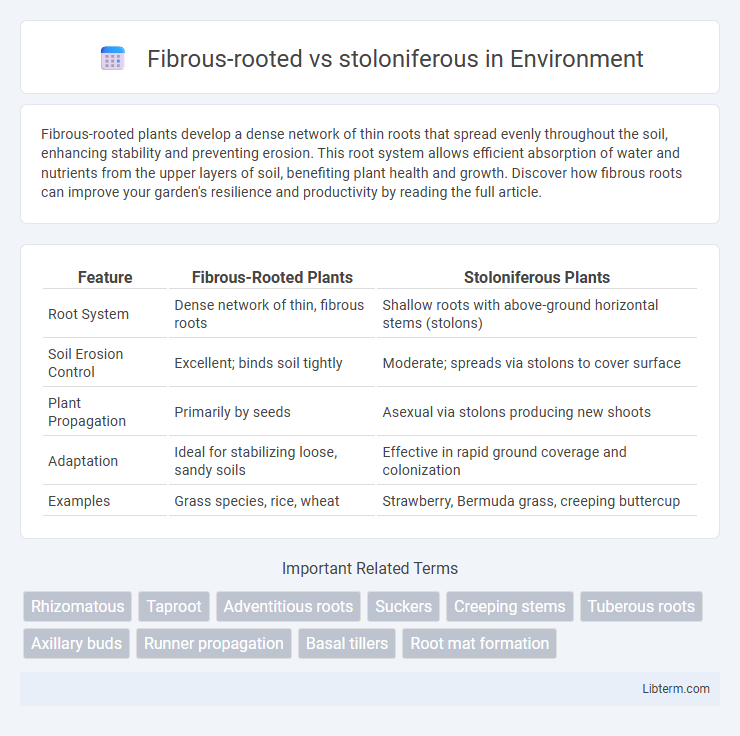Fibrous-rooted plants develop a dense network of thin roots that spread evenly throughout the soil, enhancing stability and preventing erosion. This root system allows efficient absorption of water and nutrients from the upper layers of soil, benefiting plant health and growth. Discover how fibrous roots can improve your garden's resilience and productivity by reading the full article.
Table of Comparison
| Feature | Fibrous-Rooted Plants | Stoloniferous Plants |
|---|---|---|
| Root System | Dense network of thin, fibrous roots | Shallow roots with above-ground horizontal stems (stolons) |
| Soil Erosion Control | Excellent; binds soil tightly | Moderate; spreads via stolons to cover surface |
| Plant Propagation | Primarily by seeds | Asexual via stolons producing new shoots |
| Adaptation | Ideal for stabilizing loose, sandy soils | Effective in rapid ground coverage and colonization |
| Examples | Grass species, rice, wheat | Strawberry, Bermuda grass, creeping buttercup |
Introduction to Root Systems
Fibrous-rooted systems consist of numerous thin, branching roots that spread extensively near the soil surface, enhancing water and nutrient absorption while preventing soil erosion. Stoloniferous plants reproduce through horizontal stems, or stolons, that grow above ground and root at nodes to form new plants, allowing rapid vegetative propagation. These distinct root system strategies adapt plants to diverse environments by optimizing resource acquisition and reproductive success.
Defining Fibrous-Rooted Plants
Fibrous-rooted plants possess a dense network of thin, thread-like roots that spread out horizontally near the soil surface, promoting soil stability and efficient water absorption. These roots lack a primary dominant root, contrasting with taproot systems, and are commonly found in grasses and monocots. This root structure enhances nutrient uptake and prevents erosion by anchoring the soil effectively.
Understanding Stoloniferous Plants
Stoloniferous plants propagate through horizontal above-ground stems called stolons that root at nodes to form new plants, facilitating rapid ground cover and vegetative spread. These plants, such as strawberries and spider plants, contrast with fibrous-rooted species that develop dense, fibrous root systems primarily for soil stabilization and nutrient absorption. The stoloniferous growth habit enhances colonization of new areas and resilience in dynamic environments by forming interconnected plant networks.
Key Morphological Differences
Fibrous-rooted plants develop a dense network of thin, thread-like roots spreading uniformly, enhancing soil stabilization and nutrient absorption. Stoloniferous plants propagate through horizontal above-ground stems called stolons, which produce new shoots and roots at nodes, enabling rapid vegetative spread. The primary morphological difference lies in the root system structure, with fibrous roots anchoring firmly below ground versus stolons facilitating horizontal plant expansion above ground.
Adaptations to Environment
Fibrous-rooted plants develop dense, shallow root systems that enhance soil stabilization and maximize water absorption in dry, nutrient-poor environments. Stoloniferous plants propagate through horizontal stems called stolons, enabling rapid colonization of disturbed or open areas and efficient resource acquisition in competitive habitats. These adaptations allow fibrous-rooted species to withstand drought and erosion, while stoloniferous species excel in spreading and surviving in fluctuating environmental conditions.
Nutrient and Water Uptake
Fibrous-rooted plants develop a dense network of fine roots that enhance nutrient and water absorption from the upper soil layers, promoting efficient uptake in shallow, nutrient-rich soils. Stoloniferous plants propagate through above-ground runners, spreading horizontally to access resources over a wider area but relying less on deep root proliferation for nutrient acquisition. This growth strategy allows fibrous-rooted systems to rapidly exploit surface nutrients, while stoloniferous plants optimize resource capture through spatial expansion and contact with diverse soil patches.
Propagation and Spread
Fibrous-rooted plants develop a dense network of fine roots that enhance soil stability and absorb nutrients efficiently, promoting localized growth and resilience. Stoloniferous plants spread horizontally through above-ground runners or stolons, enabling rapid colonization of new areas by producing new shoots that root at nodes. This vegetative propagation method allows stoloniferous species to expand their territory quickly, outcompeting other plants and stabilizing their presence in various habitats.
Common Examples of Each Type
Fibrous-rooted plants like wheat, rice, and maize have dense, thin roots that provide excellent soil erosion control and nutrient absorption. Stoloniferous plants such as strawberry, Bermuda grass, and spider plant spread horizontally through above-ground runners called stolons, enabling rapid colonization of new areas. These contrasting root systems influence plant propagation strategies and habitat suitability.
Agricultural and Ecological Significance
Fibrous-rooted plants provide superior soil stabilization and prevent erosion due to their dense, interwoven root systems, which is crucial for maintaining soil health in agricultural lands. Stoloniferous plants exhibit rapid vegetative propagation through above-ground runners, facilitating quick ground cover and weed suppression in both crop production and ecological restoration projects. The contrasting root structures influence water uptake efficiency and nutrient cycling, impacting crop resilience and ecosystem biodiversity management.
Choosing the Right Root System for Cultivation
Fibrous-rooted plants develop a dense network of thin roots ideal for preventing soil erosion and efficiently absorbing surface nutrients, making them suitable for shallow soils and erosion-prone areas. Stoloniferous plants spread through above-ground runners, enabling rapid ground coverage and vegetative propagation, which is beneficial for ground stabilization and quick colonization of open spaces. Selecting the right root system depends on soil type, cultivation goals, and environmental conditions, with fibrous roots favored for nutrient uptake in loose soils and stoloniferous growth preferred for aggressive spreading and coverage.
Fibrous-rooted Infographic

 libterm.com
libterm.com